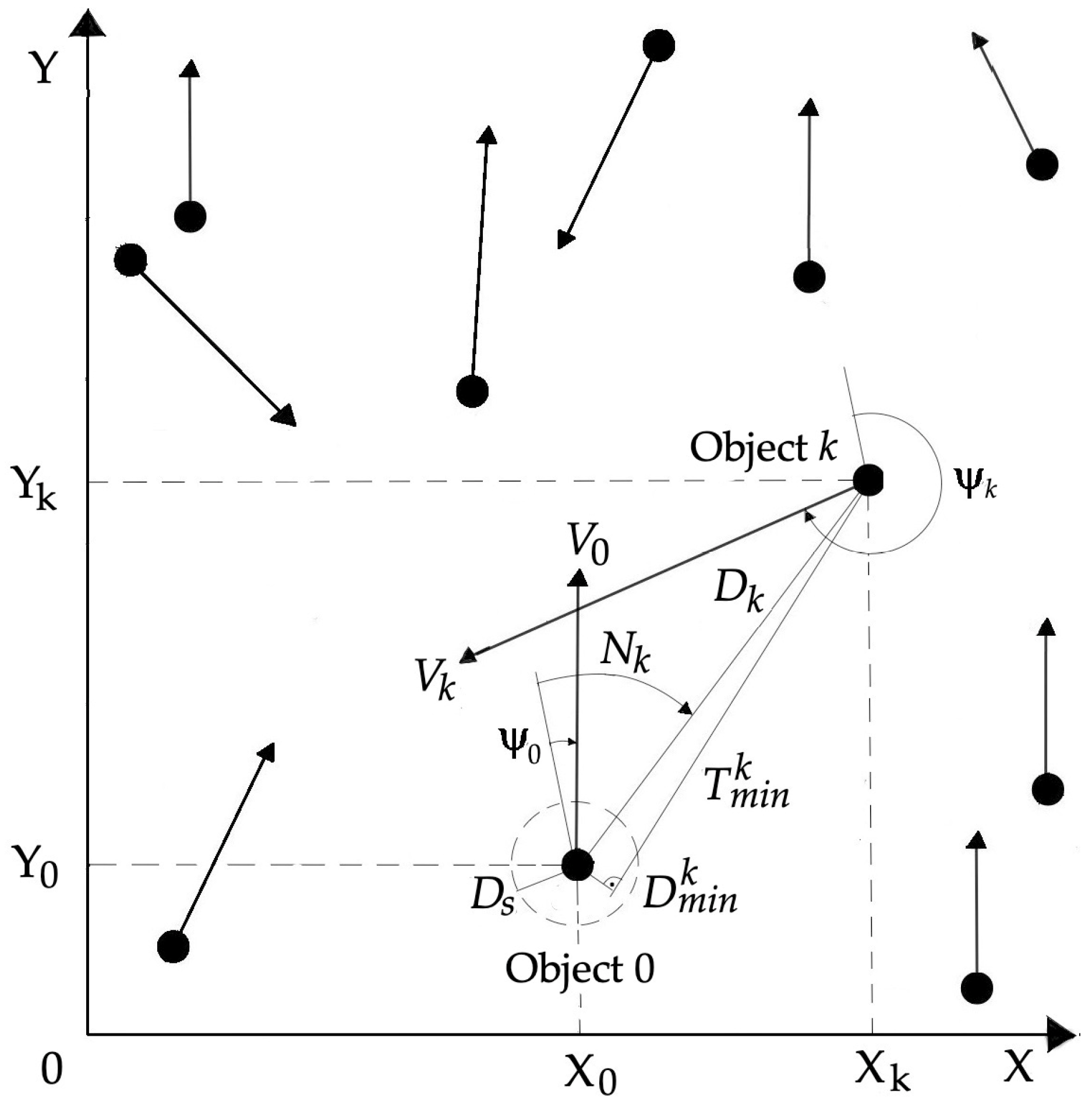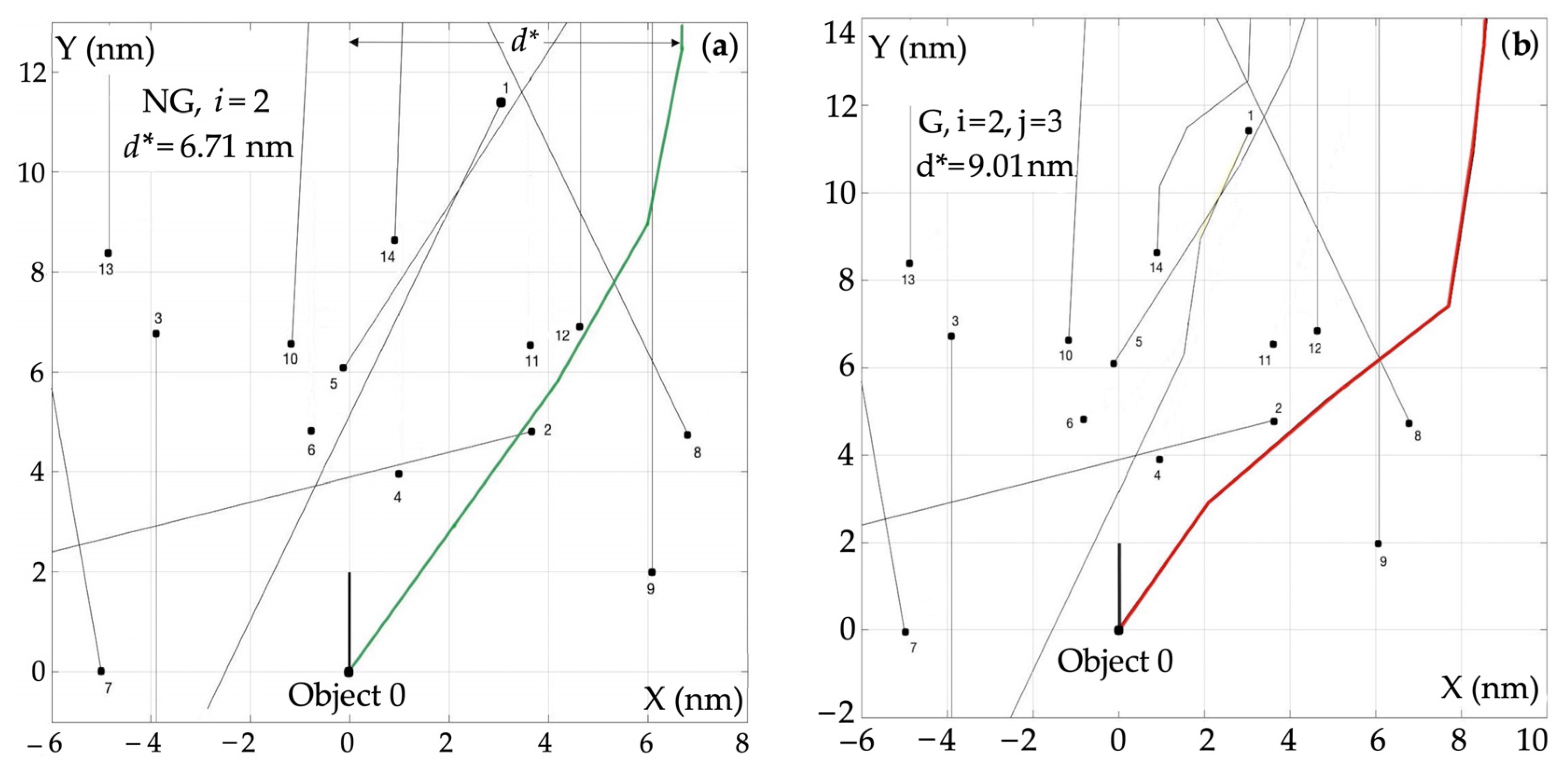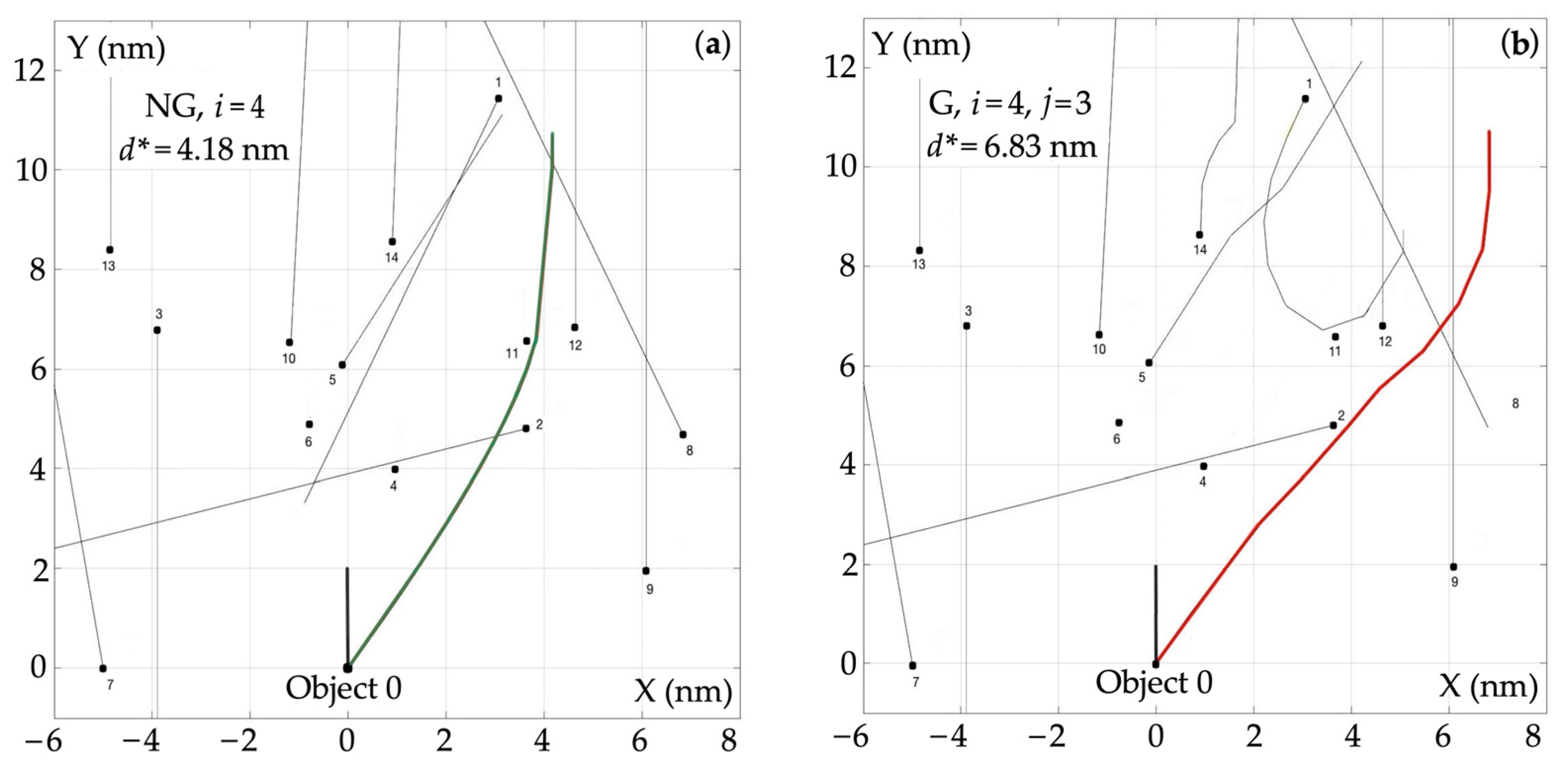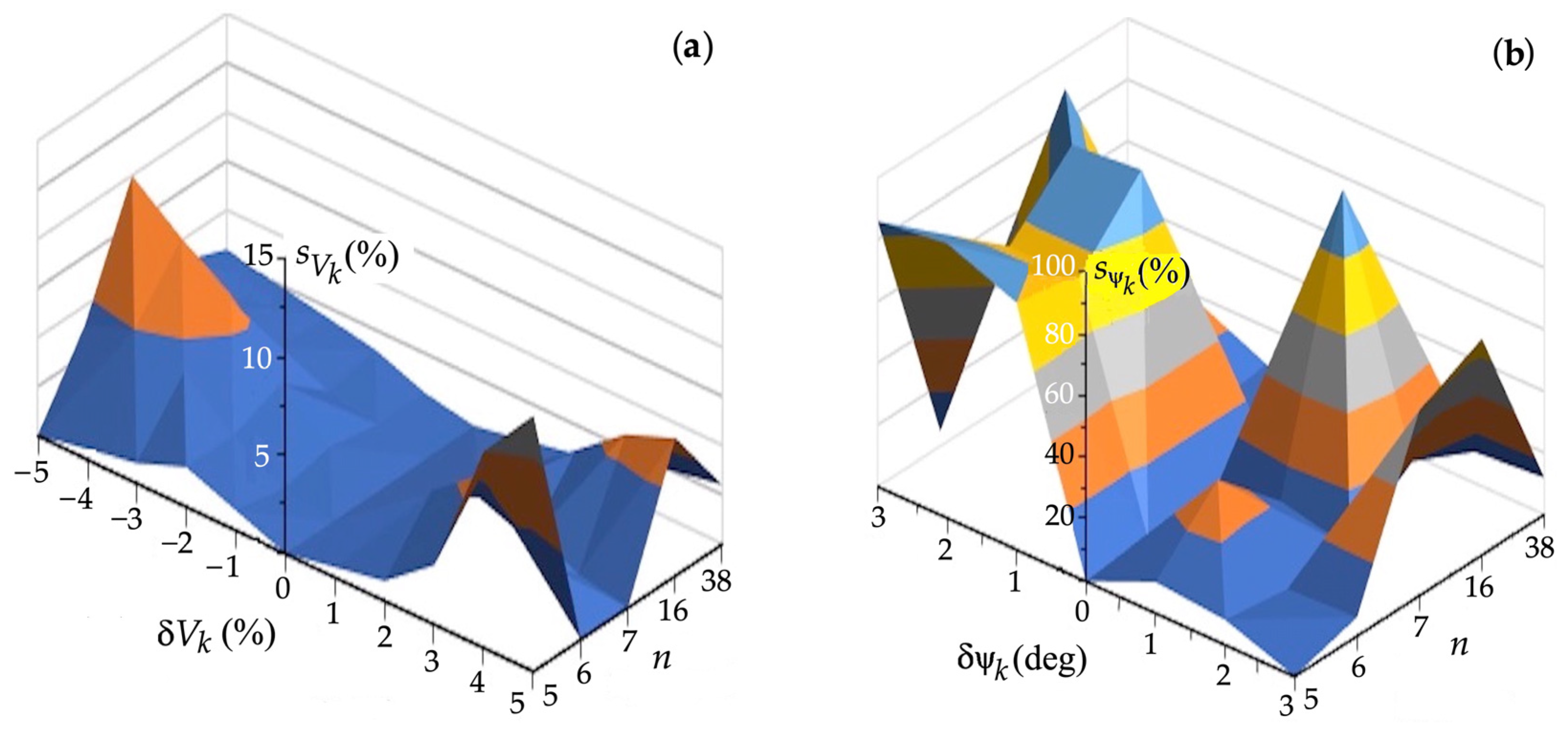Submitted:
18 June 2023
Posted:
19 June 2023
You are already at the latest version
Abstract
Keywords:
1. Introduction
1.1. State of Knowledge
1.2. Paper Thesis and Objectives
1.3. Paper Content Plan
2. Autonomous Surface Object Control Process
3. Algorithms for Determining a Safe Trajectory
3.1. Game Control Algorithm
| Algorithm 1: Game control of autonomous surface object. |
 |
3.2. Non-Game Control Algorithm
| Algorithm 2: Non-game control of autonomous surface object. |
 |
4. Computer Simulation
4.1. Comparison of Trajectories for Optimality
- The greater number of admissible strategies available for the objects, i.e., the greater the angular resolution of the course change, the smaller the deviation d* of the safe trajectory: for the non-game algorithm NG, about three times and for the game algorithm G, about two times;
- With a small number of acceptable strategies, the deviation of the safe path is 30–60% greater for the G algorithm than for the NG algorithm;
- With a greater number of acceptable strategies, the safe path deviation becomes 200 ÷ 300% greater for the G algorithm than for the NG algorithm.
4.2. Safe Control Sensitivity
- Log speed δV0, δVk: ±0.5 kn;
- Gyrocompass course δψ0, δψk: ±0.5°;
- Radar distance δDk: ±0.05 nm, bearing δNk: ±0.25°;
- COLREG safe distance δDs: +100%/−40%; subjective error of the navigator in assessing the situation.
- Sensitivity is the greatest source of measurement errors for angular variables of the process state in the form of course and bearing;
- Sensitivity increases with increasing traffic safety requirements, defined by safe distance Ds between objects;
- Sensitivity decreases with increasing step time ts value;
- Underestimating own speed V0 is better than overestimating because the risk of collision increases as the speed of the moving object increases;
- Sensitivity decreases with an increase in the number of acceptable strategies, n, of autonomous surface objects k, which is a positive feature of robust control systems on the impact of any external influences, and results from the possibility of more accurate control with a larger number n of acceptable control strategies.
5. Conclusions
- The multi-stage matrix game model enables the synthesis of a computer program for calculating the safe path of an autonomous surface object through a group of other autonomous surface objects that can perform unforeseen maneuvers;
- The safe path of an autonomous surface feature and its deviation from its initial trajectory depends on the number of allowed strategies for this autonomous surface feature and other autonomous surface features; the greater the angular resolution of the course change, the smaller the deviation of the safe path from the initial direction of motion;
- Based on the sensitivity characteristics of the collision risk, the required accuracy of measurement can be determined for individual state variables—the speed and course of objects, as can the distance and bearing to objects.
- Development of a process model that takes the non-linear dynamic properties of objects into account;
- Appropriate semantic interpretation of COLREG requirements;
- More accurate representation of the optimal control process using selected methods of artificial intelligence.
Funding
Institutional Review Board Statement
Informed Consent Statement
Data Availability Statement
Conflicts of Interest
References
- Zhao, J.; Yan, W.; Jin, X. Brief review of autonomous surface crafts. ICIC Express Lett. 2011, 5, 4381–4386. [Google Scholar]
- Barrera, C.; Padron, I.; Luis, F.S.; Llinas, O. Trends and challenges in unmanned surface vehicles (USV): From survey to shipping. TransNav Int. J. Mar. Navig. Saf. Sea Transp. 2021, 15, 135–142. [Google Scholar] [CrossRef]
- Choi, J.; Park, J.; Jung, J.; Lee, Y.; Choi, H.T. Development of an Autonomous Surface Vehicle and Performance Evaluation of Autonomous Navigation Technologies. Int. J. Control Autom. Syst. 2020, 18, 535–545. [Google Scholar] [CrossRef]
- Chen, Y.; Chen, X.; Zhu, J.; Lin, F.; Chen, B.M. Development of an Autonomous Unmanned Surface Vehicle with Object Detection Using Deep Learning. In Proceedings of the IECON 2018—44th Annual Conference of the IEEE Industrial Electronics Society, Washington, DC, USA, 26 December 2018; pp. 5636–5641. [Google Scholar] [CrossRef]
- Sneha, T. The Design and Control of an Economical Autonomous Surface Vehicle for Object Detection; Princeton University: Princeton, NJ, USA, 2020. [Google Scholar]
- Omrani, E.; Mousazadeh, H.; Omid, M.; Masouleh, M.T.; Jafarbiglu, H.; Salmani-Zakaria, Y.; Makhsoos, A.; Monhaseri, F.; Kiapei, A. Dynamic and static object detection and tracking in an autonomous surface vehicle. Ships Offshore Struct. 2020, 15, 711–721. [Google Scholar] [CrossRef]
- Zhang, M.; Zhao, D.; Sheng, C.; Liu, Z.; Cai, W. Long-Strip Target Detection and Tracking with Autonomous Surface Vehicle. J. Mar. Sci. Eng. 2023, 11, 106. [Google Scholar] [CrossRef]
- Lee, M.F.R.; Lin, C.Y. Object Tracking for an Autonomous Unmanned Surface Vehicle. Machines 2022, 10, 378. [Google Scholar] [CrossRef]
- Hongguang, L.; Yong, Y. Fast Path Planning for Autonomous Ships in Restricted Waters. Appl. Sci. 2018, 12, 2592. [Google Scholar] [CrossRef]
- Zhou, C.; Gu, S.; Wen, Y.; Du, Z.; Xiao, C.; Huang, L.; Zhu, M. The review unmanned surface vehicle path planning: Based on multi-modality constraint. Ocean. Eng. 2020, 200, 107043. [Google Scholar] [CrossRef]
- Du, Z.; Negenborn, R.R.; Reppa, V. Review of floating object manipulation by autonomous multi-vessel systems. Annu. Rev. Control. 2022, 1, 1. [Google Scholar] [CrossRef]
- Martins, A.; Almeida, J.M.; Ferreira, H.; Silva, H.; Dias, N.; Dias, A.; Almeida, C.; Silva, E.P. Autonomous Surface Vehicle Docking Manoeuvre with Visual Information. In Proceedings of the IEEE International Conference on Robotics and Automation, Roma, Italy, 10–14 April 2007. [Google Scholar] [CrossRef]
- Park, H.; Ham, S.H.; Kim, T.; An, D. Object Recognition and Tracking in Moving Videos for Maritime Autonomous Surface Ships. J. Mar. Sci. Eng. 2022, 10, 841. [Google Scholar] [CrossRef]
- Li, J.; Zhang, G.; Shan, Q.; Zhang, W. A Novel Cooperative Design for USV-UAV Systems: 3D Mapping Guidance and Adaptive Fuzzy Control. IEEE Trans. Control. Netw. Syst. 2022, 11, 1–11. [Google Scholar] [CrossRef]
- Wang, W.; Gheneti, B.; Mateos, L.A.; Duarte, F.; Ratti, C.; Rus, D. Roboat: An Autonomous Surface Vehicle for Urban Waterways. In Proceedings of the IEEE/RSJ International Conference on Intelligent Robots and Systems (IROS), Macau, China, 3–8 November 2019; pp. 6340–6347. [Google Scholar] [CrossRef]
- Hongguang, L.; Yong, Y. COLREGS-Constrained Real-time Path Planning for Autonomous Ships Using Modified Artificial Potential Fields. J. Navig. 2018, 72, 588–608. [Google Scholar] [CrossRef]
- Kim, H.G.; Yun, S.J.; Choi, G.H.; Ryu, J.K.; Suh, J.H. Collision Avoidance Algorithm Based on COLREGs for Unmanned Surface Vehicle. J. Mar. Sci. Eng. 2021, 9, 863. [Google Scholar] [CrossRef]
- Zhong, S.; Wen, Y.; Huang, Y.; Cheng, X.; Huang, L. Ontological Ship Behavior Modeling Based COLREGs for Knowledge Reasoning. J. Mar. Sci. Eng. 2022, 10, 203. [Google Scholar] [CrossRef]
- Hu, L.; Hu, H.; Naeem, W.; Wang, Z. A review on COLREGs-compliant navigation of autonomous surface vehicles: From traditional to learning-based approaches. J. Autom. Intell. 2022, 1, 100003. [Google Scholar] [CrossRef]
- Sun, Z.; Sun, H.; Li, P.; Zou, J. Self-organizing cooperative pursuit strategy for multi-USV with dynamic obstacle ships. J. Mar. Sci. Eng. 2022, 10, 562. [Google Scholar] [CrossRef]
- Lisowski, J. Multi-criteria Optimization of Multi-step Matrix Game in Collision Avoidance of Ships. TransNav—Int. J. Mar. Navig. Saf. Sea Transp. 2019, 13, 125–131. [Google Scholar] [CrossRef]
- Eslami, M. Theory of Sensitivity in Dynamic Systems; Springer-Verlag: Berlin, Germany, 1994; ISBN 978-3-662-01632-9. [Google Scholar]
- Rosenwasser, E.; Yusupov, R. Sensitivity of Automatic Control Systems; CRC Press: Boca Raton, FL, USA, 2000; ISBN 978-0-849-3229293-8. [Google Scholar]












| Autonomous Surface Object k |
Speed Vk (kn) |
Course ψk (deg) |
Distance Dk (nm) |
Bearing Nk (deg) |
|---|---|---|---|---|
| 0 | 12 | 0 | 0 | 0 |
| 1 | 9 | 206 | 11.8 | 15 |
| 2 | 18 | 256 | 6.0 | 37 |
| 3 | 12 | 180 | 7.8 | 330 |
| 4 | 0 | 0 | 4.1 | 14 |
| 5 | 6 | 33 | 6.1 | 359 |
| 6 | 0 | 0 | 4.9 | 270 |
| 7 | 8 | 359 | 5.0 | 85 |
| 8 | 18 | 334 | 8.3 | 55 |
| 9 | 15 | 0 | 6.4 | 72 |
| 10 | 13 | 3 | 6.7 | 350 |
| 11 | 0 | 0 | 7.5 | 29 |
| 12 | 12 | 0 | 8.3 | 34 |
| 13 | 6 | 0 | 9.7 | 330 |
| 14 | 5 | 2 | 8.7 | 6 |
| Strategies Sets | Our Autonomous Surface Object 0 | Other Autonomous Surface Objects k |
|---|---|---|
| A |
i = 2 |
j = 3 |
| B |
i = 3 |
j = 3 |
| C |
i = 4 |
j = 3 |
| D |
i = 13 |
j = 3 |
| E |
i = 13 |
j = 25 |
Disclaimer/Publisher’s Note: The statements, opinions and data contained in all publications are solely those of the individual author(s) and contributor(s) and not of MDPI and/or the editor(s). MDPI and/or the editor(s) disclaim responsibility for any injury to people or property resulting from any ideas, methods, instructions or products referred to in the content. |
© 2023 by the authors. Licensee MDPI, Basel, Switzerland. This article is an open access article distributed under the terms and conditions of the Creative Commons Attribution (CC BY) license (http://creativecommons.org/licenses/by/4.0/).





